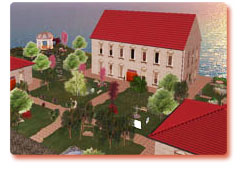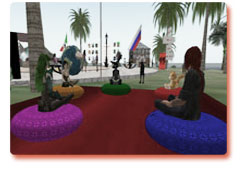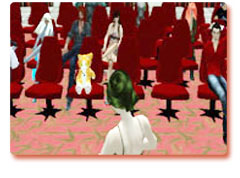Virtual World Training
The market for training is very large, globally well in excess of $100 billion, encompassing a wide range of activities and disciplines. Many well defined discrete markets exist within the overall industry. For example, pilot flight training is divided between military and civilian aircraft, and each of these is further divided into subsets of prop vs jet, single or multi-engine. Governments, corporations, and public sector entities all have a need for training employee populations is a vast variety of tasks. These can be physical and specific - how to operate a new product, how to service and repair equipment, how to manufacture an item, etc. They can be intellectual - salesmanship, using a software upgrade, learning standardized processes, professional continuing education. They can even be behavioral in nature, whether voluntary - motivational seminars - or required by regulation - sexual harassment, etc.
 In the US alone, the corporate training market is over $58 billion. Of that, $16 billion is services and outsourcing. In order to cut training costs, for many years there has been a steady uptake of new alternatives to live, group gatherings. These include distance learning, delivery of content by CD or DVD, and a wave of different online methods. The primary goals have been to reduce the cost of a live gathering and to reduce the amount of time any single employee must be away from their primary job. The challenge for any training program has always been to engage and retain the attention of the audience, who, for the most part, would rather be somewhere else, even doing their real job.
In the US alone, the corporate training market is over $58 billion. Of that, $16 billion is services and outsourcing. In order to cut training costs, for many years there has been a steady uptake of new alternatives to live, group gatherings. These include distance learning, delivery of content by CD or DVD, and a wave of different online methods. The primary goals have been to reduce the cost of a live gathering and to reduce the amount of time any single employee must be away from their primary job. The challenge for any training program has always been to engage and retain the attention of the audience, who, for the most part, would rather be somewhere else, even doing their real job.
 One potentially powerful solution that will eliminate travel costs and more fully capture and focus the attention of training participants is the use of virtual worlds for online delivery of training sessions. Applied to a broad range of training curriculums, this is a market transforming opportunity.
One potentially powerful solution that will eliminate travel costs and more fully capture and focus the attention of training participants is the use of virtual worlds for online delivery of training sessions. Applied to a broad range of training curriculums, this is a market transforming opportunity.
The gaming industry has led the way in developing ever more lifelike virtual worlds and modeling lifelike characters which are controlled either by the player or the computer. The most recent trend has been toward MMORPGs - Massively Multiplayer Online Role Playing Games. These are themed online line environments in which thousands of players can simultaneously inhabit the world and interact with both the world and each other. They are characterized by avatars, the player created character which moves and performs actions under player control. A key element is the inclusion of text or voice chat, by which the players engage in real time communication. Character control and communication lead to a greater sense of immersion into the virtual space.
 More recently, Linden Labs has created Second Life, a virtual world which has been defined by its users. Linden Labs has created (and sells) the in-world real estate, but the members build their own structures and landscapes. LL provides the tools for creating an avatar, clothing, etc. There is an economy inside of Second Life with a currency that converts to real dollars. The sale of these Linden dollars is one of the revenue streams for LL, but it has also allowed members to generate income from the sale of items they have created inworld. The level of graphics realism of the avatars and environments is not cutting edge, but the freedom to create and socialize is near absolute. As of March, 2008, there were 13 million member accounts, with roughly 38,000 members online at any given moment. Linden Labs has specifically targeted the corporate world, marketing Second Life as the portal for a real time global presence for a company's particular brand and products, delivered as a virtual representation. The benefits offered include building customer affinity through customer interaction, showing products in a virtual store, allowing instant addition or removal of product offerings and incentive programs, and online promotional events.
More recently, Linden Labs has created Second Life, a virtual world which has been defined by its users. Linden Labs has created (and sells) the in-world real estate, but the members build their own structures and landscapes. LL provides the tools for creating an avatar, clothing, etc. There is an economy inside of Second Life with a currency that converts to real dollars. The sale of these Linden dollars is one of the revenue streams for LL, but it has also allowed members to generate income from the sale of items they have created inworld. The level of graphics realism of the avatars and environments is not cutting edge, but the freedom to create and socialize is near absolute. As of March, 2008, there were 13 million member accounts, with roughly 38,000 members online at any given moment. Linden Labs has specifically targeted the corporate world, marketing Second Life as the portal for a real time global presence for a company's particular brand and products, delivered as a virtual representation. The benefits offered include building customer affinity through customer interaction, showing products in a virtual store, allowing instant addition or removal of product offerings and incentive programs, and online promotional events.

A key strength of the 3D platform is the nearly limitless flexibility in training design and atmosphere. Some examples include:
- Creation of a traditional classroom or auditorium
- Simulations of on-the-job situations
- Simulations of machine or system operations
- 3D training games
- Multi-lingual sessions with live translators
- Short session modules designed to fit into users time constraints
A New Frontier

The "metaverse" of virtual reality that science fiction writers dreamed only two decades ago has arrived and is here today. This has powerful implications for the future of how business will be conducted. It is rare that an emerging communication technology offers lower costs and enhanced effectivenes, but virtual reality can offer that to your organization today.
Put our years of research and experience in this medium to work for you today. We can guide you through each step, and create anything from a simple lecture hall to a massive interactive cityscape.

